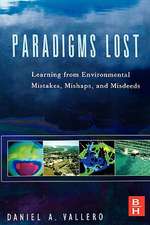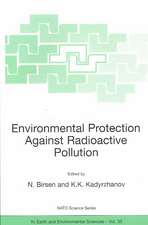Radiation-Induced Processes of Adaptation: Research by statistical modelling
Autor Victoria L. Korogodina, Boris Florko, Ludmila P. Osipovaen Limba Engleză Paperback – 18 iun 2015
| Toate formatele și edițiile | Preț | Express |
|---|---|---|
| Paperback (1) | 635.80 lei 6-8 săpt. | |
| SPRINGER NETHERLANDS – 18 iun 2015 | 635.80 lei 6-8 săpt. | |
| Hardback (1) | 644.95 lei 6-8 săpt. | |
| SPRINGER NETHERLANDS – 5 iun 2013 | 644.95 lei 6-8 săpt. |
Preț: 635.80 lei
Preț vechi: 748.00 lei
-15% Nou
Puncte Express: 954
Preț estimativ în valută:
121.67€ • 132.12$ • 102.21£
121.67€ • 132.12$ • 102.21£
Carte tipărită la comandă
Livrare economică 22 aprilie-06 mai
Preluare comenzi: 021 569.72.76
Specificații
ISBN-13: 9789401783354
ISBN-10: 9401783357
Pagini: 204
Ilustrații: XVII, 183 p.
Dimensiuni: 155 x 235 x 11 mm
Greutate: 0.29 kg
Ediția:2013
Editura: SPRINGER NETHERLANDS
Colecția Springer
Locul publicării:Dordrecht, Netherlands
ISBN-10: 9401783357
Pagini: 204
Ilustrații: XVII, 183 p.
Dimensiuni: 155 x 235 x 11 mm
Greutate: 0.29 kg
Ediția:2013
Editura: SPRINGER NETHERLANDS
Colecția Springer
Locul publicării:Dordrecht, Netherlands
Public țintă
ResearchCuprins
1. Introduction.- 2. Disturbance of the hereditary material reserves is the main instrument of stress.- 3. Excursus on statistical modeling for population biology. Statistical solution of some radiobiological tasks.- 4. Non-linearity induced by low-dose rates irradiation. Lab experiments on pea seeds.- 5. Adaptation and genetic instability in ecology. Study of the influence of nuclear station fallouts on plant population.- 6. Instability process across generation. 6. Consequences of nuclear test fallouts for inhabitants.- 7. Conclusion.- 8. Applications.
Textul de pe ultima copertă
In recent decades radiobiologists’ efforts have been directed at identifying the mechanisms of radiation effects; the general mechanisms have since been studied extensively. This book describes and analyzes radiation-induced adaptation as processes produced in cells, tissues, and populations. This viewpoint helps to understand the nature and factors of induced processes, to determine the characteristics of observed radiation effects and their limitations. The investigations presented here were founded on proper lab experiments, ecological studies of plant population growth near an operating nuclear power plant and a thorough epidemiological examination of human populations living in territories polluted fifty years ago, as well as on relevant published data. This research demonstrates the radiation-induced adaptation processes that continue even when the radiation itself is no longer at a critical background level. The investigations utilized the method of statistical modeling on the basis of distributions on the number of abnormalities. This method allows us to investigate the processes induced by low-dose factors when accompanied by Darwinian selection in different systems; the distribution parameters can then be used to study the characteristics of adaptation processes and system resistance.
The consequences of background-level radiation continue to provoke debate, and the mathematical bases of the adaptation model are shown, while due consideration is paid to the components of adaptation: instability, selection, and proliferation. The book will be especially useful to specialists in radiation pollution, ecology, epidemiology, and radiology for studies of radiation-induced processes; the method presented here can also be adapted to investigate low-dose effects in other fields. In addition, the book presents a number of reviews in the fields of radiation biology, including pioneering investigations inRussia which were previously unavailable to Western scientists.
The consequences of background-level radiation continue to provoke debate, and the mathematical bases of the adaptation model are shown, while due consideration is paid to the components of adaptation: instability, selection, and proliferation. The book will be especially useful to specialists in radiation pollution, ecology, epidemiology, and radiology for studies of radiation-induced processes; the method presented here can also be adapted to investigate low-dose effects in other fields. In addition, the book presents a number of reviews in the fields of radiation biology, including pioneering investigations inRussia which were previously unavailable to Western scientists.
Caracteristici
The offered method of statistical modelling identifies the characteristics of adaptation and instability processes in populations Adaptation processes were analysed in the cases of lab experiments, ecology and epidemiology investigations The instability process was considered on the genomic, cellular, and population levels. Stimulation of cells’ proliferation was discussed too Can be used as manual to statistical modelling which could be advanced in the other fields: radiotherapy, social sciences and so on Includes supplementary material: sn.pub/extras

























